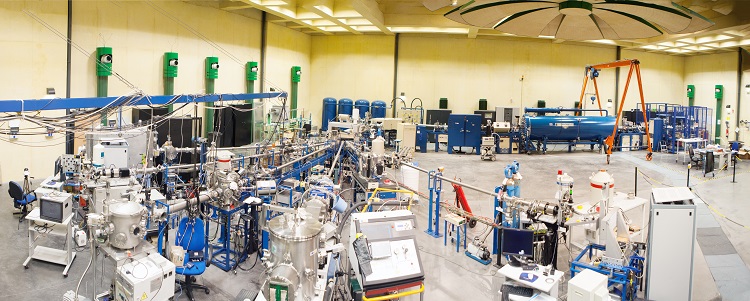Lines
At the present time, Tandem accelerator has six available beam lines to characterize and to modify materials, as well as for Nuclear Physics research.
Â
-30° Beam Line: Nuclear Physics Beam Line. In this beamline different nuclear instrumentation (detectors, electronics, etc) is developed and tested. This instrumentation will be used in international Nuclear Physics facilities.
Â
-15° Beam Line: Microbeam Chamber. The microprobe focusing system was manufactured by Oxford Microbeam Ltd. It is possible to form a spot of a few microns on the specimen with this system. Elemental maps that provide the spatial distribution concentration in the samples are obtained with the scanning mode. The scanning coils allow a maximum scanning area of 2.5x2.5 mm2 for 3 MeV protons.
Â
0° Beam Line: Multipurpose IBA Chamber. This target chamber has been designed to carry out RBS, PIXE, NRA and PIGE experiments simultaneously. A set of gamma-particle and X-Ray detectors is used to combine all these IBA techniques.
Â
0° Beam Line: Ionoluminescence Chamber. Linked to the multipurpose chamber, this vacuum chamber is equipped with black coating walls, a sample temperature heater, a control monitor and a photonic diagnostic system that allows mainly ionoluminescence studies. Furthermore, several access ports allow locating detectors to perform IBA experiments at temperatures up to 500 °C.
Â
 Â
Â
Beam lines
Â
+15° Beam Line: Irradiation Chamber. This home-made scattering chamber has been designed to allow the irradiation of large areas (16x20 cm2) by raster scanning of the beam through magnetic deflection.
Â
+30° Beam Line: Channeling Chamber. This line is primarily devoted to channeling analysis of crystalline samples. A well-defined parallel beam is obtained with a telescopic system formed by two slit assemblies, each one incorporating four independent tantalum slit elements.
Â
The beam line also includes a BPM and a Faraday cup. The chamber is equipped with two particle detectors and an X-Ray detector. The sample holder is mounted in a 4-axis klinger/microcontrol goniometer with X-tilt and Y-tilt angular positioning.
Â
+45° Beam Line: External Beam. This line is mainly used in Art and Archaeometry studies. Due to the frequent inhomogeneous nature of this kind of objects, the use of external ion beam analysis (combined with a good resolution) exhibits numerous advantages.
Â
With the idea of achieving good spatial resolutions (~ 60 ÎĽm), a series of elements have been purchased from Oxford Microbeams, including a precision four-jaw object slit and an exit nozzle set with micrometer adjustment.
Â
HISPANoS Line. HISPANoS, from Hispalis Neutron Source, is the first accelerator based neutron source in Spain. At HISPANoS, neutrons are produced in a high energy range covering from thermal to fast neutrons up to 9 MeV through the reactions p (7Li, n), d (D, n), p (9Be, n) and d (9Be, n). Its implementation has allowed expanding the research lines already developed with charged particles and photons at CNA. The main research application of the new neutron source are related to astrophysics, medical physics, detector characterization, electrical devices irradiation for aerospace purposes, neutron radiography, among others.
Â
In 2018, the upgrade of the 3 MV tandem accelerator has been completed. Such upgrade consisted on a buncher and chopper system and a new experimental line dedicated to neutron time of flight (ToF) measurements. This new system was designed to produce protons and deuterons pulsed beams with a pulse width of 1-2 ns at the target position. Pulse frequency can be varied from 32.5 kHz to 2 MHz.
Â
Further information:Â HISPANoS Line



 Â
  Â
 


